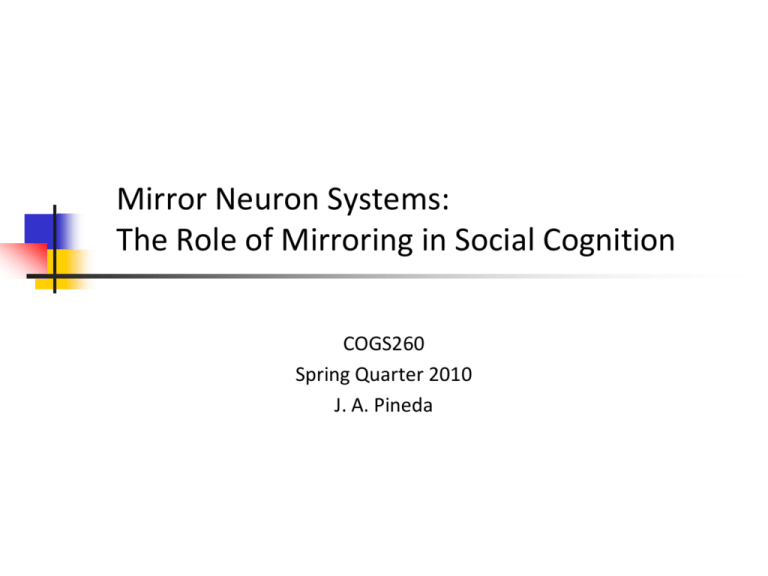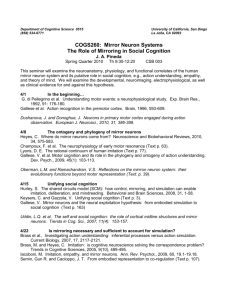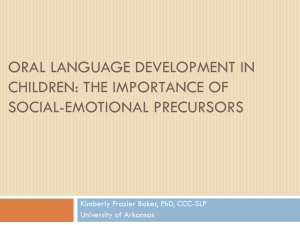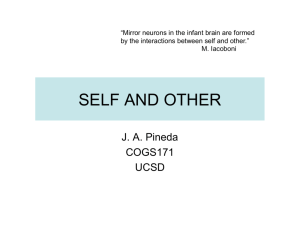Mirroring system
advertisement

Mirror Neuron Systems: The Role of Mirroring in Social Cognition COGS260 Spring Quarter 2010 J. A. Pineda Social Cognition Social cognition refers to the mental processes by which we make sense of our social worlds. Accounting for these complex dynamics requires an understanding of the cognitive structures and processes that shape the individual’s understanding of the social situation A core assumption of how humans understand and infer the intentions and beliefs of others is the existence of a functional self-other distinction. Classic Explanation Theory-Theory argument from analogy disembodied knowledge visual hypothesis A Different Perspective Simulation Theory Direct-matching hypothesis Embodied knowledge Map visual information onto motor representations of the same action Mirroring systems Bridges between perception and action that allow for simulation Mirror neurons EEG Mu rhythms Ideomotor action A Different Perspective Simulation Theory Direct-matching hypothesis Embodied knowledge Map visual information onto motor representations of the same action Mirroring systems Bridges between perception and action that allow for simulation Mirror neurons EEG Mu rhythms Ideomotor action Bandura’s (early) Social Learning Theory Emphasized the means by which we acquire behavior or Learning… Operant Conditioning Classical (Pavlovian) Conditioning But especially, via observational learning or Imitation Albert Bandura Imitation “The capability to acquire new skills by observation, based on the imitator’s existing behavioral repertoire” “Learning by observing and mimicking the behavior of others” This form of learning is not limited to a sensitive period Many predators, including cats and coyotes, seem to learn some of their basic hunting tactics by observing and imitating their mother Imitation (cont) In his "Bobo doll" studies, Bandura showed that children (ages 3 to 6) would change their behavior by simply watching others. He observed three different groups of children: • One group of children saw a child praised for aggressive behavior (rewarded) • A second group saw the child told to go sit down in a corner and was not allowed to play with the toys (punished) • A third group saw a film with the child simply walking out of the room (no consequence) Imitation (cont) Bandura et al also demonstrated that viewing aggression by cartoon characters produces more aggressive behavior than viewing live or filmed aggressive behavior by adults. Furthermore, they showed that having children view prosocial behavior can reduce displays of aggressive behavior. Learning Aggressiveness Imitation via Television This 14-month-old boy is imitating behavior he has seen on TV Does imitation require a theory of mind or does it create it? Emergence of understanding other minds (Meltzoff, 2005) Imitation Intrinsic connection between observed and executed acts, as manifest by newborn imitation (Meltzoff & Moore, 1997). ↓ First-person experience Infants experience the regular relationship between their own acts and underlying mental states. ↓ Understanding Other Minds Others who act "like me" have internal states "like me." TV, Imitation, and Prior Experience Is Imitation innate? Piaget, 1951 imitation is learned by 2yrs Meltzoff & Moore 1977, 1983 Newborns can imitate facial and manual gestures Interpretations of Neonatal Imitation Innate Releasing Mechanisms A reflex mechanism that evolved specifically for neonatal imitation of specific gestures Coincidence Neonatal imitation “results from a coincidental matching of interesting visual stimuli with infants’ behavioral expressions of interest” (p. 1968) Active Intermodal Matching (AIM) (Meltzoff & Moore, 1977, 1997) Why do we imitate? It is rewarding dopamine release? To learn about the world Is it the same for infants and adults? A prelude and the facilitator of verbal communication among children Facilitates an embodied ‘intimacy’ between self and others during social relations an intersubjectivity; empathy; mind reading Echopraxia The involuntary repetition or imitation of the observed movements of another. Echopraxia as a released behavior (Dromard, 1905; Stengel, 1947; Ford, 1989) Observed in Autism, Tourette’s syndrome, ‘idiocy’, hypnosis, fatigue Compulsive imitation observed in patients with Utilization behaviors (Lhermitte et al., 1986): a frontal lobe disorder in which the patient has difficulty resisting the impulse to operate or manipulate objects which are in their visual field and within reach. What is the basis for this social learning? Selective attention Motor primitives Classification-based learning system Specialized neurons Susan Hurley’s Shared Circuits Model (SCM) This model connects perception-action mechanisms (such as mirror neurons) with dynamics of self-other. Places these mechanisms as part and parcel of the situated cognition movement How do you go from “mirroring” to “action understanding”? The assumption is that perception is an active process and that cognition is embodied and situated. Embodiment: the unique way an organism’s sensorimotor capacities enable it to successfully interact with its environment Situated means learning happens as a human being interacts with the world SCM HYPOTHESIS: Associations derived from an agent’s own movement can yield mirroring and simulations of similar perceived movements by others. *** What specifically is mirroring? What is simulation? How is it distinguished from own movement? SCM This conceptualization is the undoing of the “Sandwich” conception of the mind The assumption that there is a layer of input and a layer of output and cognition processes are somehow sandwiched in-between the two. The new view is that perception and action can emerge from the same processes. Neural Systems At least two neural systems have been proposed to manage self/other distinction Classic motor system: specialized for the preparation and execution of motor actions that are self realized and voluntary, Mirroring system: primarily involved in capturing and understanding the actions of non-self or others. Evolved to share many of the same circuits involved in motor control. Bridge between perception and action that allows for simulation Mirroring System Mirroring or ‘shared circuit systems’ are assumed to be involved in Resonating Imitating Simulating the actions of others Shared representations of motor actions may form a foundational cornerstone for higher order social processes Each time an individual observes another individual performing an action, a set of neurons that encode that action is activated in the observer’s cortical motor system. Mirror Neurons in Parietal-Frontal Circuit Discharge both when the monkey performs an action and when it observes a similar action done by another monkey or an experimenter Found in: area F5 (homolog of Broca’s area); 10-20% inferior parietal cortex (PF/7b) Activated by: Goal directed actions (reaching, grasping, holding) Observation of similar actions performed by “biological” agents Rizzolatti and Sinigaglia, Nature Reviews Neurosci, 2010 Mirror Neuron Activity Rizzolatti et al., Cogn. Brain Res., 1996, 3:131-141 What do mirror neurons encode during movement? F5 neurons discharged during the same phase of grasping in both conditions, regardless of whether this involved opening or closing of the hand Umiltà, M. A. et al. Proc. Natl Acad. Sci. USA, 2008. What do mirror neurons encode during observation? Grasping Umiltà et al. Neuron, 2001 Mimicking Perception-to-Action Mapping Selectivity Congruent (effector dependent) Perception Action Logically-Related (effector independent; 2X) Encoding goal in an observer-centered spatial framework Why does the motor system encode the goal of actions performed by others? Allow the observer to understand directly the goal of the actions of others without needing inferential processing …although there are several mechanisms through which one can understand the behaviour of other individuals, the parieto-frontal mechanism is the only one that allows an individual to understand the action of others ‘from the inside’ and gives the observer a first-person grasp of the motor goals and intentions of other individuals. Rizzolatti and Sinigaglia, 2010 Differences Between Monkey/Humans Monkeys imitate the goal and not the individual movements; In humans, the mirroring system also becomes active during the observation of individual movements Mirror neurons seem tailor-made for imitation; yet monkeys (at least) are rotten imitators (monkeys aren’t chimps) maybe necessary element but not sufficient The Mirror Neuron System Sensorimotor cortex Inferior parietal lobule Inferior frontal gyrus Superior temporal sulcus Iacoboni and Dapretto, Nature Reviews, 2006,7:942-951 Pineda, Beh & Brain Functions, 2008, 4, 47 Functional Significance Response facilitation Mimicry Simulation Imitation learning Understanding actions Understanding intentions Empathy Theory of Mind Language Controversy: Do human MNs exist? Some have argued that the activation of the same areas during action observation and action execution via fMRI is not sufficient to prove the existence of the mirror mechanism in humans Motor areas have distinct, segregated populations of visual and motor neurons, the visual neurons discharging during action observation and the motor neurons during action execution. Repetition–Suppression Technique If mirror neurons exist in humans, they should ‘adapt’ when the observation of a motor act is followed by the execution of that motor act, and vice versa. True only when information repeatedly reaches a neuron through the same or largely common pathways Other Controversies/Questions Do MNs reflect understanding? Do they reflect intention? Are they born or made? Is the system broken in patients with social deficits? Are they the basis for theory of mind, empathy, language? Watching actions you can do or can’t do… Imitating what we know Dance videos Ballet Capoeira Subjects Ballet dancers Capoeira dancers Expert Non-expert Non-expert Expert Expert vs non-expert Mirror neuron areas Experts show more mirror system brain activity than non-experts Calvo-Merino et al., Cerebral Cortex (2005) Other Problems Mirroring systems present at least three problems Correspondence Development Control problem Problems (cont) Correspondence How does the observer agent know what the observed agent’s resonance activation pattern is? How does the matching of motor activation patterns occur? Problems (cont) Developmentally How does a mirroring system arise? How do humans acquire the ability to simulate through mapping observed onto executed actions? Are mirror neurons innate and therefore genetically programmed? To what extent is learning necessary? Problems (cont) Control How to efficiently control a mirroring system when it is turned on automatically through observation? Or, as others have stated the problem more succinctly: “Why don’t we imitate all the time?” Correspondence Problem Common coding facilitates imitation, avoiding the correspondence problem and the need for translation between input and output codes What are the neural mechanisms possible for common coding? Canonical neurons: fire when an animal perceives an object that affords a certain type of action and when the animal performs the afforded action Mirror neurons: fire when an animal perceives another agent performing a type of action, and also when the animal performs that type of action itself What Is It Like To Be…? Can aspects of subjective experience be reduced to brain activity? Thomas Nagel, The Philosophical Review 83 (1974). Mirroring: A Fundamental Organizational Feature of the Brain? “Understanding others as intentional agents may be grounded in the relational nature of our interactions with the world” Beyond understanding actions What’s the role of experience? Context? Attention? Emotions and the root of empathy? Sounds and other senses? Relationship to Language? Problems in “mirroring” Consequences of mirroring dysfunction? Aberrant imitation learning: addiction?







